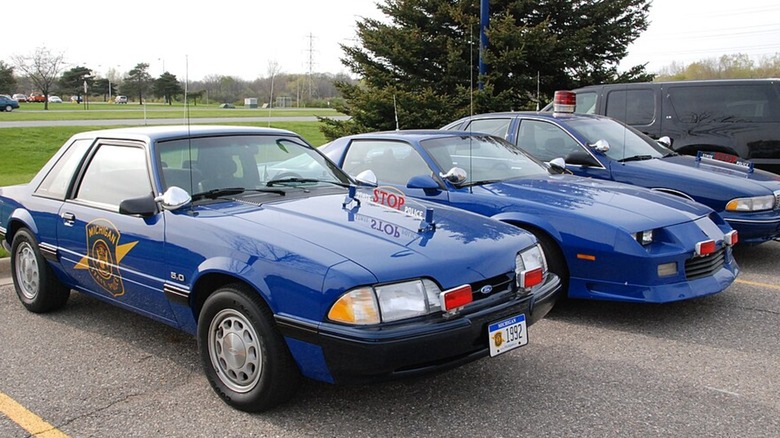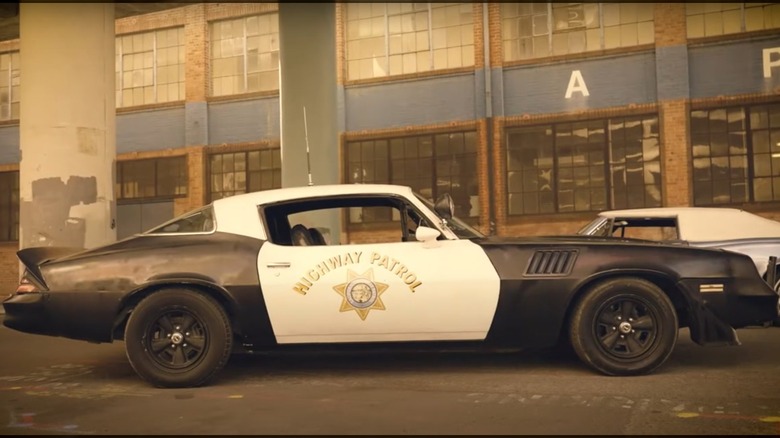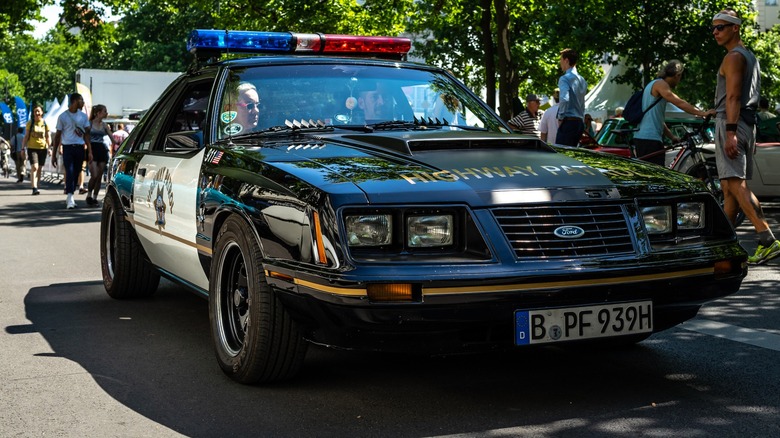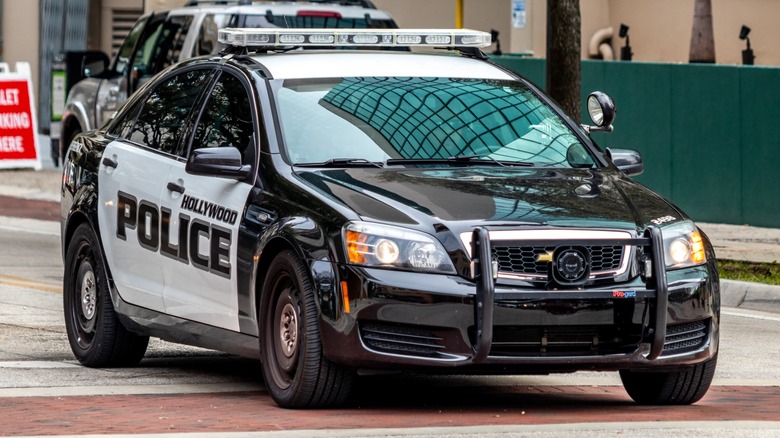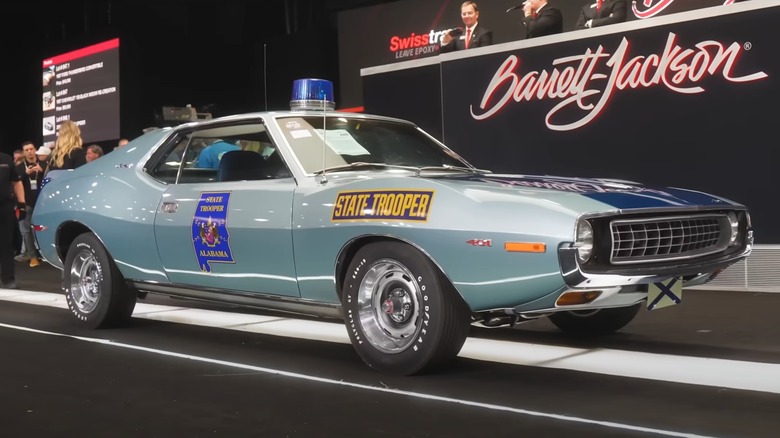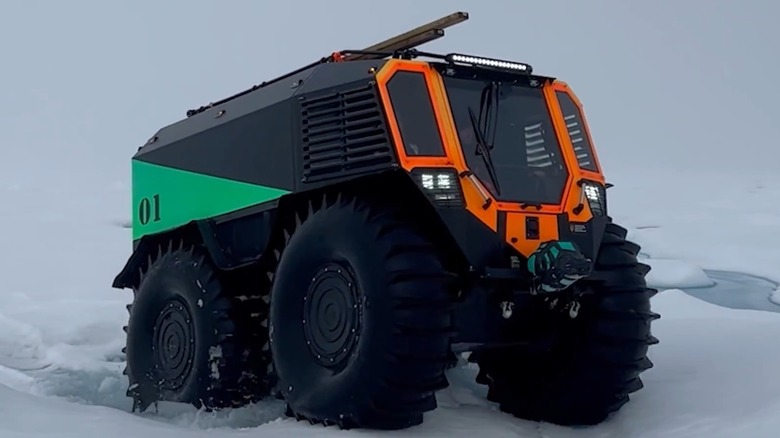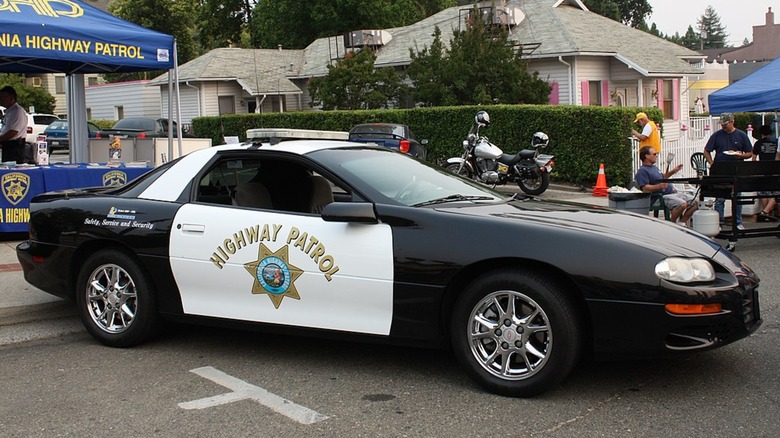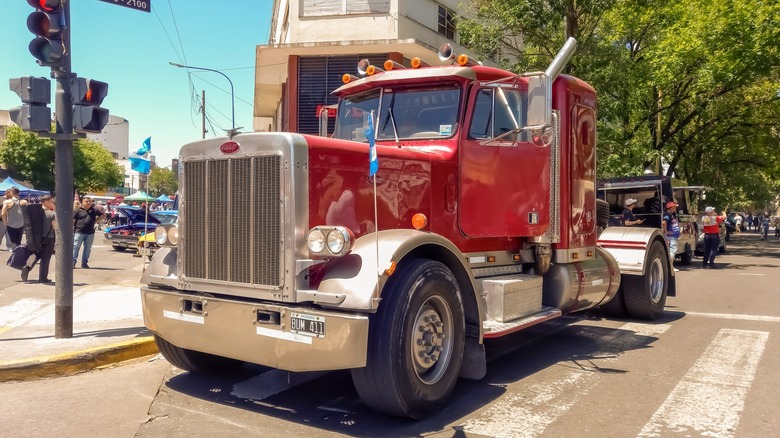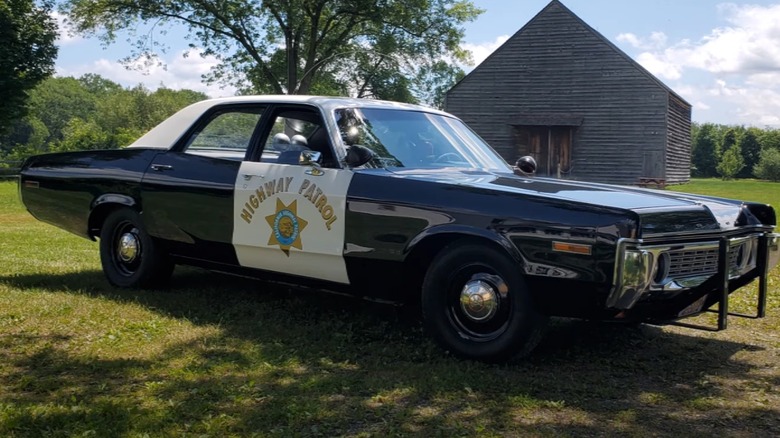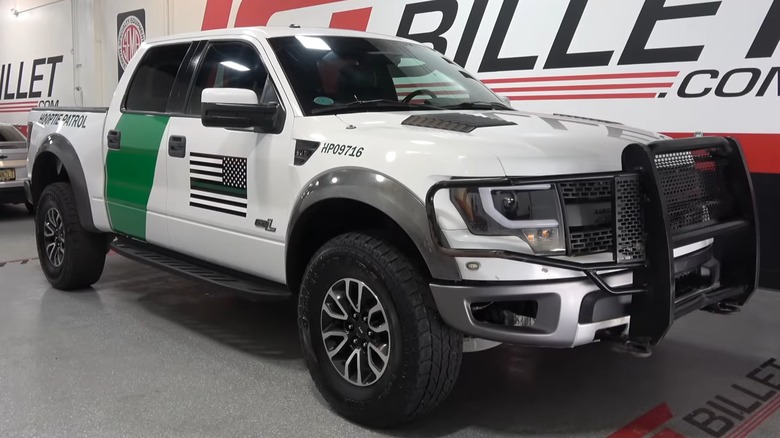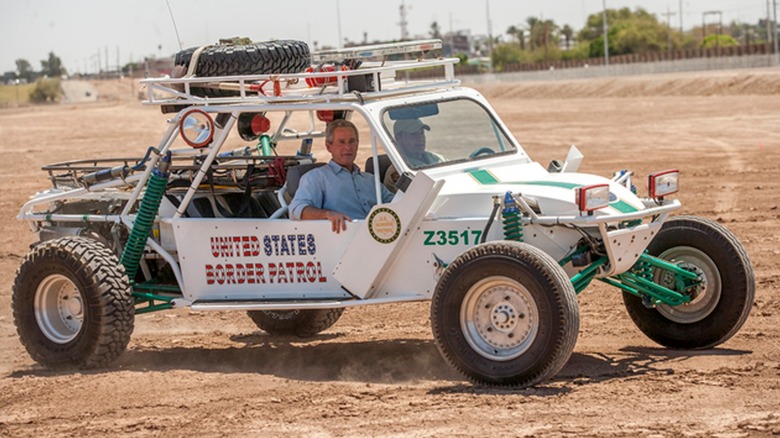11 Of The Coolest Police Cars In America
Since America's first full-time municipal police force was established in Boston in 1838, police departments have evolved into today's sophisticated, tech-savvy organizations. A significant part of that evolution involves transportation, once dominated by foot patrols and horse-drawn wagons. The emergence of the automobile drastically altered policing, giving officers unprecedented mobility but also added responsibilities.
The origin of the police car dates back to 1899 when Akron, Ohio bought an electric wagon for transporting arrestees. The first police passenger car appeared in 1909 when the Detroit police commissioner bought a Packard for the force using his own money, as the city declined his request for funds. Police cars have changed a lot since then, but the cars cops drive have largely been regular passenger cars, usually sedans. Hauling the accused to jail have long been the same cars used for getting kids to soccer practice.
However, occasionally the cops get their hands on more-desirable vehicles. Sometimes they drive fast, powerful cars meant for keeping up with violators that turn out to be fun and engaging to drive. Periodically, police get to drive vehicles that are actually cool, just like these 11 examples. Furthermore, none of them were confiscated from drug dealers, only to be displayed by DARE at county fairs in failed attempts to prevent teen drug use. All of these cars have been used for actual police work.
Chevrolet Camaro Z28
For West Coast drivers who use a heavy foot, the appearance of a California Highway Patrol vehicle in the rearview mirror has never been a welcome sight. This is true now and was certainly no different back in the 1970s. But back then, police cars tended to be big, heavy, lumbering sedans with underpowered engines thanks to recently enacted emissions controls. So the CHP launched a Special Purpose Vehicle Study in 1979 to find troopers a car to keep up with lawbreakers.
The study began with the purchase of 12 1979 Chevrolet Camaro Z28 models split up and assigned to Redding, Bakersfield, El Centro, and West Los Angeles for testing. These cars received an exemption from the California Air Resources Board, a state-level equivalent to the EPA, for an axle-ratio change from 3.42:1 to 3.08:1 for better acceleration. Also, brakes and tires were swapped for high-speed police versions.
All of the Camaros came equipped with 350-cubic-inch-displacement V8 engines making just 170 horsepower. During testing, nine cars suffered blown engines with no more than 26,000 miles, although replacements with four-bolt main bearing caps resolved the issue. Not much more information about this program appears to be available except that these cars were tested in real-world situations, and most importantly, the CHP decided against ordering more cars from Chevrolet due to a competitor coming in with a similar car for a lower bid.
Ford Mustang SSP
When the CHP considered buying a fleet of Camaro Z28s as high-speed cruisers for patrol at $11,445 each, Ford swooped in with a bid of $6,868 for its newly redesigned Mustang. However, the Fox platform on which that car rides was first offered with a police package on the 1978 Ford Fairmont, complete with a choice of 80-horsepower inline-6 or 139-horsepower V8. This platform option was superseded by the LTD Special Service Package in 1984, but the CHP had already found its Fox-bodied solution, the 1982 Mustang Special Service Package.
Unhappy with the results of its Camaro test pilot program, the CHP placed an order for 400 Mustangs. Using the legendary 225-horsepower 5.0-HO V8 equipped with upgraded engine and transmission cooling, heavy-duty suspension, and reinforced floor pans providing increased body rigidity, these new compact police cruisers could sprint to 60 mph in 6.3 seconds and have a much better chance of catching up with the baddies.
Eventually, law enforcement agencies across the country adopted the Mustang SSP, including federal agencies such as the FBI and the DEA. Nearly all of them came in the two-door notchback body style with either a five-speed manual or automatic transmission, depending on agency preferences. Perhaps the coolest application of this model happened when the Air Force acquired them to use as chase vehicles to assist in landing the Lockheed U-2 spy plane. Ford ended Mustang SSP production after the 1993 model year as Corvette-powered Caprices introduced in 1994 made them obsolete.
Chevrolet Caprice
Chevrolet first offered its Caprice 9C1 police car in 1986, a slow, boxy, generally dull sedan widely used in fleet service and hardly a cool cop car. Things improved with the revised Caprice 9C1 in 1994, particularly for the newly installed LT1 V8 from the Corvette. But even as this faster, less boxy sedan — also adapted into one of the best factory sleeper cars ever produced, the Chevy Impala SS — upped the cool factor, it was still just a big sedan with decent horsepower. Only in 2011 did the police-package Caprice become a cool, desirable car.
What made the 2011 Caprice different from its forebears was what lay beneath its black-and-white exterior. Indeed, the chassis underpinning this Caprice came from Down Under. Like the discontinued Pontiac G8 sports sedan, the Caprice PPV used a platform originating in a Holden factory in Australia, where it was also known as Caprice but sold to everyone. What this meant for North American law enforcement personnel was the option of having an LS V8 to keep up with the perps on the run.
Caprice PPV models offered fleet buyers a 301-horsepower V6 or 355-horsepower V8, although the 384 pound-feet of torque from the LS is what gave it some genuine grunt and a zero to 60 mph time under six seconds. And with a 6-speed automatic transmission and limited-slip differential, it could reach 156 mph, the fastest production cop car ever as of 2019, and that's pretty cool.
AMC Javelin 401
Some of the most desirable cars built in America come from the muscle-car era of the early '70s, when horsepower reigned supreme and appealing styling remained abundant. In those days, drivers had options like the Dodge Hemi Challenger, or Pontiac GTO "The Judge." This presented a problem for troopers on highway patrol duty as their standard police cruisers just could not keep up.
But if you sped through Alabama, you might have come to regret it. To keep up with the powerful muscle cars coming out of Detroit, the Alabama Department of Public Safety went to American Motors Corporation for a solution. They found one in the 1971 AMC Javelin, a true muscle car. The cash-strapped Alabama police turned to AMC because their Ford prices had risen, and cash-strapped AMC was happy to earn the business.
Alabama worked out a deal to buy the AMC Javelin SST equipped with the larger optional 401 V8 equipped with a partial AMC Go-Package, including heavy-duty cooling, heavy-duty suspension, and power front disc brakes. Power steering and air conditioning, a necessity for sweltering Alabama summers, also made it onto the cars. Additionally, the optional rear spoilers were added to allow for high visibility "STATE TROOPER" decals on the rear. Though 133 cars in '71 and '72 made it into service, most did not survive the abuse endured on duty. The remaining few are highly collectible and probably the coolest cop cars ever made.
Sherp N 1200
While not exactly a car, the Sherp N 1200 is a vehicle and is used by police. Currently in service in multiple jurisdictions including Coconino County, Arizona and Williams County, North Dakota, these Sherps serve similar duties in dramatically different environments.
Manufactured in Ukraine by Quadro International, the Sherp N 1200 gives law enforcement robust capabilities to trek far off the highway into rugged territory where few other vehicles can pass. With all-wheel-drive on giant paddle tires that enable flotation and movement through water, the most remote areas become accessible. Furthermore, wheels on the left or right can operate independently, similarly to tank tracks, and are operated with tank-like control levers. Onboard central tire inflation makes it possible to adjust grip for sand and snow while deflating the tires can lower its height for passing through tight spaces. A 1.8L three-cylinder diesel engine provides efficient, reliable torque for extended operations.
Sherps are incredibly versatile and have found use worldwide by a wide range of organizations as well as private owners. For law enforcement, their primary use focuses on search and rescue missions, which is why they are popular in places like the wilds of the Dakotas and the vast scorching desert of Arizona. Maybe the Sherp is not a car, but there is no denying it is very cool.
Chevrolet Camaro B4C Special Service Police Package
Although the California Highway Patrol's Camaro Z28 models tested in 1979 failed to result in any orders, in 1991 Chevrolet prepared a police package for the Camaro and introduced the Chevrolet Camaro B4C Special Service Police Package. Chevrolet continued offering the B4C package through the next generation in 1993 and ended it only because all production ended in 2002, until the 5th-gen Camaro revival made its debut in the 2009 "Transformers" movie.
With the B4C package, agencies received a car equipped with a mix of parts from the Z28 and the 1LE racing package. This included the LT1 V8 through 1997 and the LS1 V8 from 1998 to 2002. A six-speed manual or four-speed automatic could be chosen, with the manual option removed in 2000. Otherwise, a limited-slip differential, performance handling components, transmission and engine oil coolers, upgraded electrical systems, and a 150-mph speedometer completed the package.
With advances in technology over the B4C production period, cars built at the end came better equipped and with more performance capabilities. The LS1 V8 produced 310 horsepower, sending power through a four-speed automatic transmission while a limited-slip differential ensured it grabbed the pavement. De Carbon monotube shocks, rear anti-sway bars, and computer-selected coil springs provided sure-footed cornering while Z-rated 16-inch Goodyears kept it all in check. Regardless of any impressive performance stats and despite its detractors, the 4th-gen "catfish" Camaro is a cool car, and even a lawman's badge can't diminish that.
Peterbilt 379
One of the most significant dangers on our highways today causes way too many senseless deaths. Texting while driving takes a driver's attention away from the road, so anything can happen, and the lack of focus can and does lead to tragedy. According to the National Highway Transportation Safety Administration, 3,308 people died from this carelessness in 2022 alone. According to a study in the American Journal of Public Health, enforcement of laws banning texting while driving resulted in a 3% reduction of fatalities. While that may be a small number, any life saved is worth it.
The Tennessee Highway Patrol has an interesting tool to enforce its anti-texting laws, a Peterbilt 379 pulling a standard 40-foot trailer down the state's highways. Investing in a Peterbilt would be wasteful, as big rigs cost an extraordinary amount of money, especially when compared to the cost of a typical police cruiser. However, the Tennessee Highway Patrol acquired this Peterbilt from a drug trafficker using it to transport large amounts of cannabis through the state.
To be clear, you will not be getting pulled over by a big rig. Officers sitting high up in the cab spot distracted drivers and radio a car-based trooper nearby to initiate the stop. The rig is painted in the same livery as all Tennessee Highway Patrol cars, with a lightbar installed to its roof. To some, big rigs are pretty cool, but saving lives is cool to all.
Dodge Polara CHP
Although Chrysler vehicles fulfilled police duties starting in the 1930s, not until 1956 did an official police package exist straight from the factory. These proved popular, establishing Mopar vehicles as regular tools of the trade for law enforcement all over the country. Through the '50s and '60s, popular Dodge and Plymouth models served police duty, and much of the time throughout the '60s and '70s, departments chose the Dodge Polara for patrol vehicles.
Throughout the '60s, cars in general gained substantial amounts of horsepower, posing a problem for law enforcement driving cars built for fleet practicality and price. The most powerful engines were usually reserved for more expensive options on higher trim levels and muscle cars. However, the California Highway Patrol wanted a patrol vehicle that could keep up.
Armed with a list of required specifications regarding acceleration, braking, and durability, the CHP in 1968 tested cars from various manufacturers and only the Dodge Polara with the Mopar 440 Magnum big block V8 met every standard. Thus, the 1969 Polara Pursuit and its 375-horsepower 440 V8 became the preferred car of CHP troopers. Furthermore, it became the fastest cop car ever built when tested at 149.6 mph, a title it held until another Dodge sedan beat it in 2006. Surviving examples of the '69 Pursuit are among the coolest entries into car shows everywhere.
Ford SVT Raptor
With almost 2,000 miles of border to patrol on the line that separates the United States and Mexico, the U.S. Border Patrol has its work cut out for it. The terrain over which the border runs is largely hot, parched desert where little survives but lizards and the buzzards overhead. Nonetheless, millions attempt to cross this treacherous landscape to risk their lives in an attempt to live a better life, regardless of how difficult it might be on the other side. But the U.S. has a duty to protect the integrity of its border, and the agency with that task needs capable vehicles.
Attempting to apprehend human traffickers in the desert calls for abilities beyond the typical police cruiser. A Ford F-150 is well-equipped to reliably handle the terrain, but sometimes that still isn't enough to keep up with the coyotes. To try gaining the upper hand, Border Patrol in 2010 ordered a fleet of Ford F-150 SVT Raptors with 411 horsepower and upgraded off-road suspension.
In addition to the 6.2L V8, Border Patrol Raptors were equipped with down-facing LED lights used to spot tracks on the American side of the border — agents routinely drag tires down the length of the fence to make fresh tracks easy to spot. Additionally, passenger sun visors featured forward-looking infrared night vision for tracking people in the dark. One thing is missing from these trucks — leather seats, too hot in the desert — but they are still pretty cool.
Funco Sand Rail
With the breadth of U.S. territory, law enforcement must contend with conditions in some of the planet's harshest, most rugged environments. Many of these places make traditional passenger vehicles poorly suited for surveillance or search-and-rescue missions. Sometimes, conditions make a purpose-built vehicle the most appropriate choice. For terrain with loose sand and soil, a sand rail, aka sand car or dune buggy, is the best choice.
Many of these off-road buggies are custom-built from scratch or from kits; the Meyers Manx boosted the popularity of dune-buggy kit cars beginning in the 1960s. While home-built buggies are great for hobbyists, a few companies manufacture a range of models that can be equipped with an impressive drivetrain to provide equally impressive off-road capabilities, but at a cost of up to $100,000.
The miles of California coastline present a perfect application for dune buggies, and the state's Department of Parks and Recreation uses, or at least in the early 2000s used, Funco sand rails for patrolling beaches. With stretchers mounted to the frame, they could quickly transport people in need to safety.
The vast desert of the United States' southern border presents another ideal application, and the Border Patrol uses dune buggies for a range of operations, including providing then-President George W. Bush with a photo opportunity in 2006 (see above). As far as a cool police vehicle that is fun and exciting to drive, a dune buggy sits high on the list.
